
Amunhotep III (detail), circa 1390–1352 B.C.E. Possibly from Thebes. Wood, gilded, Total height: 103⁄8 in. (26.3 cm). Brooklyn Museum; Charles Edwin Wilbour Fund, 48.28. (Photo: Jonathan Dorado, Brooklyn Museum)

Amunhotep III (detail), circa 1390–1352 B.C.E. Possibly from Thebes. Wood, gilded, Total height: 103⁄8 in. (26.3 cm). Brooklyn Museum; Charles Edwin Wilbour Fund, 48.28. (Photo: Jonathan Dorado, Brooklyn Museum)
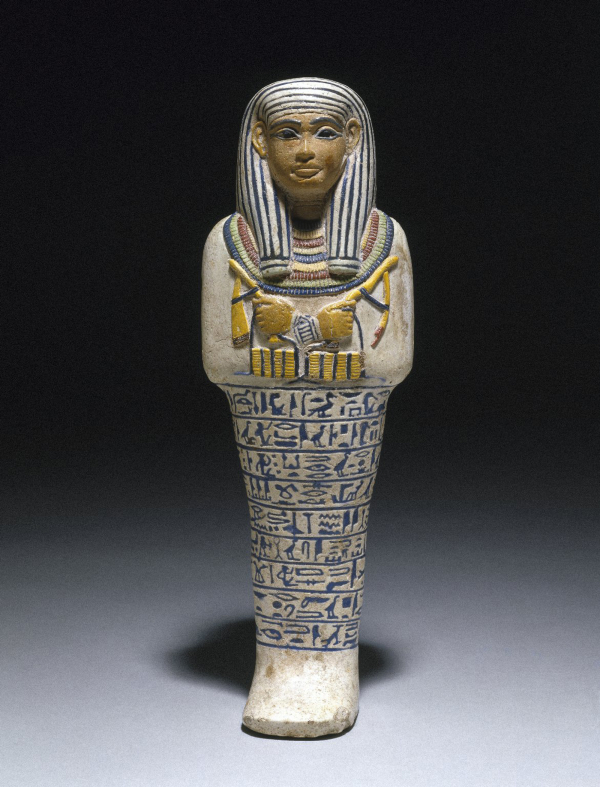
Shabty of Sati. Egypt, reportedly from Saqqara. New Kingdom, Dynasty 18, circa1390–1352 B.C.E. Faience, height 913/16 in. (25 cm). Brooklyn Museum, Charles Edwin Wilbour Fund, 37.123E

Female Figurine. Egypt, from Ma’mariya. Predynastic Period, Naqada II, circa 3500–3400 B.C.E. Terracotta, painted, 111⁄2 x 51⁄2 x 21⁄4 in. (29.2 × 14 × 5.7 cm). Brooklyn Museum, Charles Edwin Wilbour Fund, 07.447.505
Based on images painted on jars of the same date, the female figure with upraised arms appears to be celebrating a ritual. The bird-like face probably represents her nose, the source of the breath of life. The dark patch on her head represents hair, also a human trait. Her white skirt indicates a high-status individual.
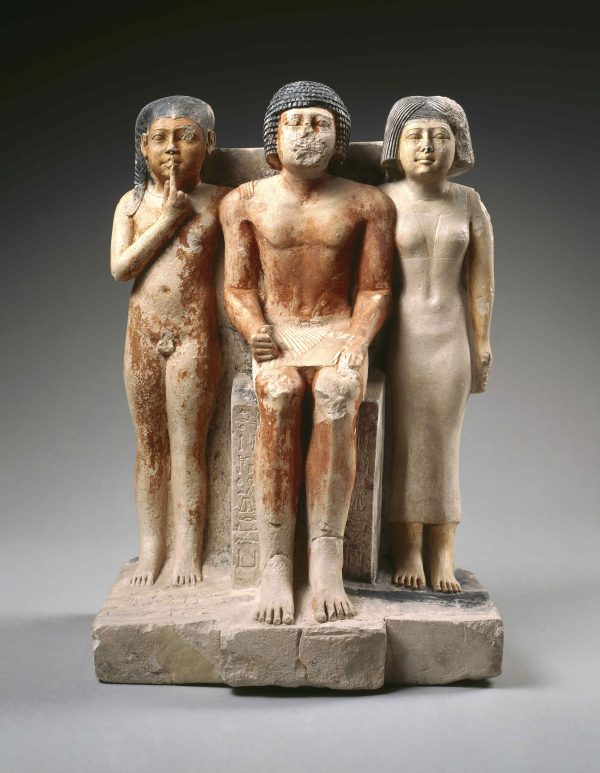
Statue of Nykara and His Family. Egypt, provenance not known. Old Kingdom, late Dynasty 5, circa 2455–2350 B.C.E. Limestone, painted, 225⁄8 x 141⁄2 x 107⁄8 in. (57.5 × 36.8 × 27.7 cm). Brooklyn Museum, Charles Edwin Wilbour Fund, 49.215
This family statue depicts Nykara, whose title is Scribe of the Granary, seated between the two standing figures of his wife and son. If Nykara were shown standing, his dimensions are such that he would tower over the other two figures. Also, although the boy’s nakedness, sidelock of hair, and finger-to-mouth gesture indicate that he is very young, he is depicted as the same height as his mother. These disproportions apparently resulted from the sculptor’s desire to show all three heads in a row.
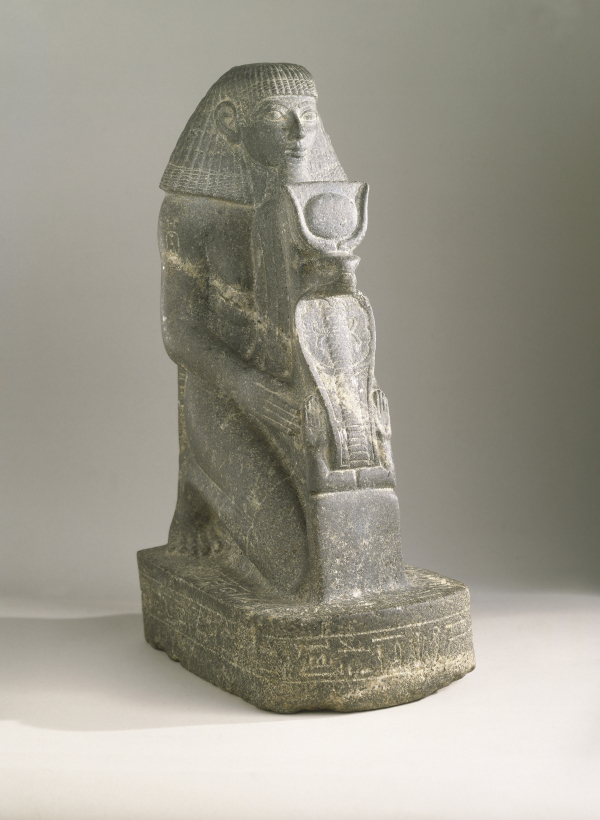
Kneeling Statue of Senenmut. Egypt, from Armant. New Kingdom, Dynasty 18, joint reign of Hatshepsut and Thutmose III, 1478–1458 B.C.E. Granite, 189⁄16 x 67⁄8 in. (47.2 × 17.4 cm), base: 63⁄4 x 215⁄16 x 119⁄16 in. (17.2 × 7.5 × 29.3 cm). Brooklyn Museum, Charles Edwin Wilbour Fund, 67.68
Occasionally an innovative artist enhanced a traditional sculptural form. This statue of Senenmut—an important official during the joint reign of Queen Hatshepsut and King Thutmose III—appears in the classic kneeling pose known since the Fourth Dynasty (circa 2625–2500 B.C.E.). Old and Middle Kingdom kneeling statues show a subject with his hands resting on his thighs or holding a pair of tiny round vessels. The sculptor of this piece, however, depicted Senenmut presenting a complex object: a cobra resting in a pair of upraised arms, wearing cow horns with a sun-disk. Egyptologists interpret this image as a cryptogram of Hatshepsut’s throne name (Ma`at-ka-re).
The sculptural form of a kneeling man holding an intricate symbolic image first appeared in statues of Senenmut and continued for hundreds of years. Perhaps this new type of statue was the product of Senenmut’s imagination, as interpreted by a skilled and receptive artist.
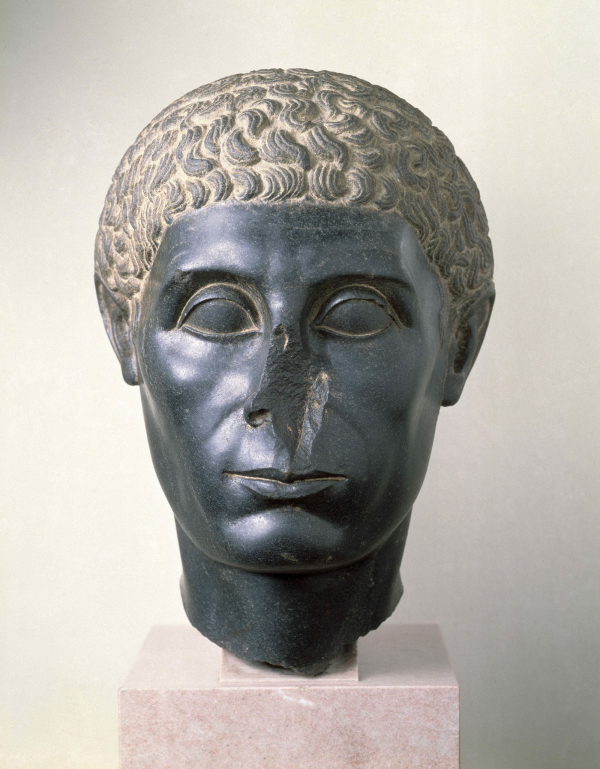
Head of an Egyptian Official. Egypt, provenance unknown, reportedly from Memphis. Ptolemaic Period, circa 50 B.C.E. Diorite, 165⁄8 in. (42.2 cm). Brooklyn Museum, Charles Edwin Wilbour Fund, 58.30
The rich, dark patina of this head is not ancient; the original surface has a duller tone. Whether the head represents an individual is a matter of dispute. It may depict a particular but now unknown priest or government official, or it may be a stylization. The curly locks reflect Hellenistic influence, an important component of Egyptian art of the ptolemaic Period, but the formulaic execution is Egyptian. One scholarly opinion holds that the face consists of many nonintegrated features drawn from disparate sources and cannot therefore be individualizing. According to this theory, the front and side views do not merge and the forehead is a schematic, unrealistic trapezoidal configuration. Likewise the facial planes are allegedly too sharply demarcated and the heavily lidded eyes are oversized hieroglyphs. The accuracy of these claims is open to question.
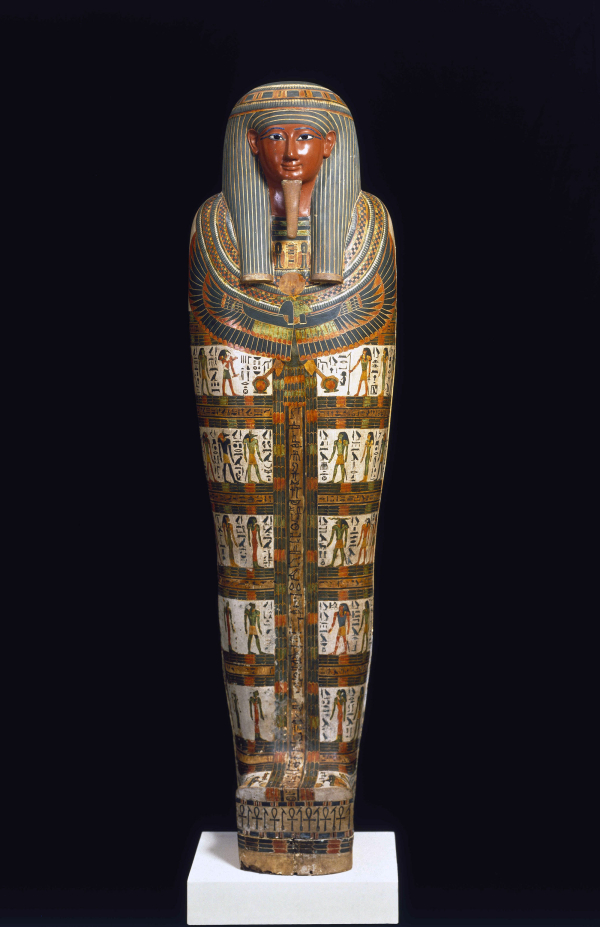
Cartonnage of Nespanetjerenpere. Egypt, probably from Thebes. Third Intermediate Period, Dynasty 22 to early Dynasty 25, circa 945–718 B.C.E. Linen or papyrus mixed with plaster, pigment, glass, lapis lazuli, height: 6911⁄16 in. (177 cm). Brooklyn Museum, Charles Edwin Wilbour Fund, 35.1265
The decoration of Nespanetjerenpare's cartonnage richly details the theme of resurrection and permanence. Above the wesekh-collar is a protective pectoral in the form of a djed-pillar and a tyet-amulet. The djed-pillar is the hieroglyphic writing of the word “stability” or “endurance,” and the sign tyet, often written in assocation with djed, expresses the idea of well-being. Below the wesekh-collar is a ram-headed falcon pendant, a representation of the solar god as he travels through the underworld at night. Ihe cartonnage base is decorated with ankh-signs and was-scepters, the hieroglyphs for “life” and “power.” The small registers in the front depict a variety of deities associated with the parts of the body—like the eyes, lips, and teeth—deities who serve to protect the owner and keep his mummy bound together for eternity.

The Wilbour Plaque. Egypt, probably from Akhetaten (“Horizon of the Aten”), modern Amarna. New Kingdom, Dynasty 18, reign of Akhenaten, probably late in his reign, circa 1352–1336 B.C.E. Limestone, 63⁄16 x 811⁄16 x 15⁄8 in. (15.7 × 22.1 × 4.1 cm). Brooklyn Museum, Gift of Evangeline Wilbour Blashfield, Theodora Wilbour, and Victor Wilbour honoring the wishes of their mother, Charlotte Beebe Wilbour, as a memorial to their father, Charles Edwin Wilbour, 16.48
One of the world's best-known works of Amarna art, the Wilbour Plaque is named for the American Egyptologist Charles Edwin Wilbour (1833–1896), who purchased it in 1881. The plaque was never part of a larger scene. Originally, it was suspended on a wall by a cord inserted through the hole at the top. Artists used it as a model for carving official images of an Amarna king and queen. The queen shown here is certainly Nefertiti; the king may be Akhenaten, hi co-regent Smenkhkare, or young Tutankhaten (later Tutankhamun).
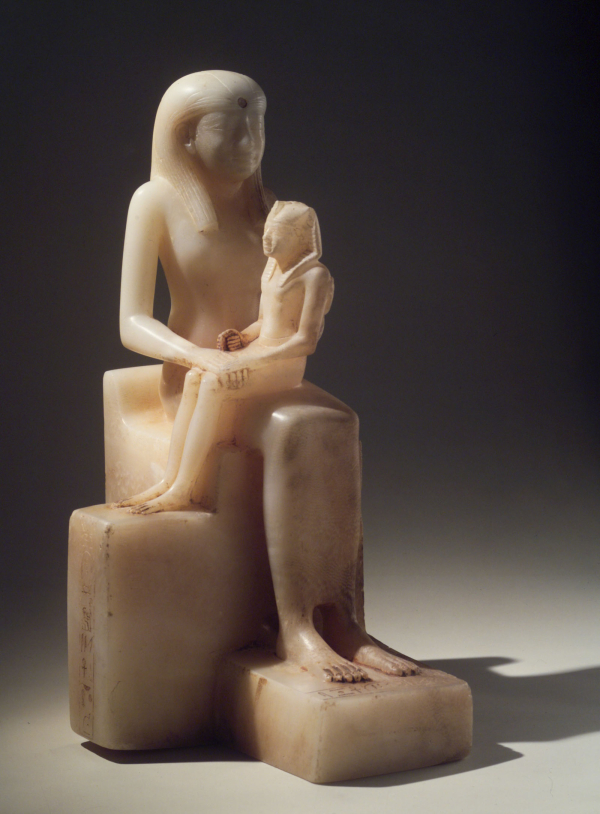
Statuette of Queen Ankhnes-meryre II and Her Son, Pepy II. Egypt, probably from Upper Egypt. Old Kingdom, Dynasty 6, reign of Pepy II, circa 2288–2224/2194 B.C.E. Egyptian alabaster, 157⁄16 x 913⁄16 in. (39.2 × 24.9 cm). Brooklyn Museum, Charles Edwin Wilbour Fund, 39.119
Pepy II became king as a small child, so his mother acted as regent. This statue conveys her role, evoking the typical Egyptian pose of a mother nursing a child. Pepy is shown as a miniature king rather than a child and, instead of nursing him, the queen holds him protectively as he clasps her hand. Each figure looks straight ahead and has its own inscription, as if it were a separate statue.
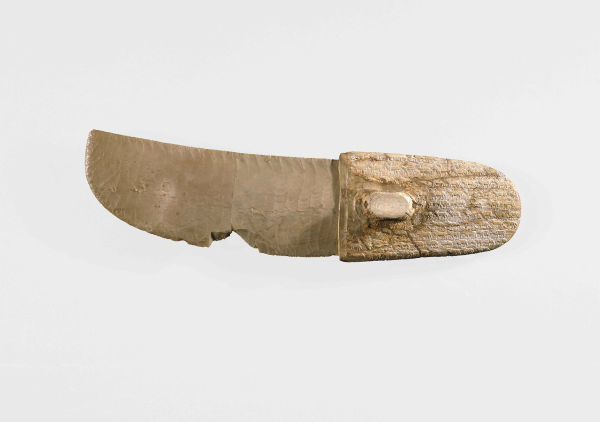
Ritual Knife. Egypt, from Abu Zaidan, Burial 32. Predynastic Period, Naqada III Period, circa 3300–3100 B.C.E. Flint, elephant ivory, 23⁄8 x 13⁄16 x 91⁄8 in. (6 × 2.1 × 23.2 cm). Brooklyn Museum, Charles Edwin Wilbour Fund, 09.889.118
The ivory handle of this superbly crafted knife includes a thumb rest for a right-handed user. Carved rows of minuscule animals—including elephants, lions, a giraffe, and sheep—cover both surfaces of the handle. An artisan polished the flint blade on one side and delicately flaked the other to make a cutting edge.

Pair Statue of Nebsen and Nebet-ta. Egypt, possibly from Dahamsha. New Kingdom, Dynasty 18, early in the reign of Amunhotep III, circa 1400–1352 B.C.E. Limestone, painted, 153⁄4 x 89⁄16 x 91⁄4 in. (40 × 21.8 × 23.5 cm). Brooklyn Museum, Charles Edwin Wilbour Fund, 40.523
To express the physical and spiritual bond between two individuals, sculptors devised a form called the pair statue. The most common variety showed the subjects—a husband and wife, a mother and child, or a king and a divinity, for example—seated together on a chair or bench. The earliest documented examples date to the reign of King Djoser in the Third Dynasty (circa 2675–2625 B.C.E.).
This New Kingdom pair statue represents a married couple. The inscription tells us that the man is Nebsen, a scribe in the royal treasury, and the woman is Nebet-ta, a singer in the temple of the goddess Isis. They each pass one arm behind the other, a symbol of closeness. In order to convey this sentiment and to create a harmonious design, the sculptor extended the arms to unnatural lengths.
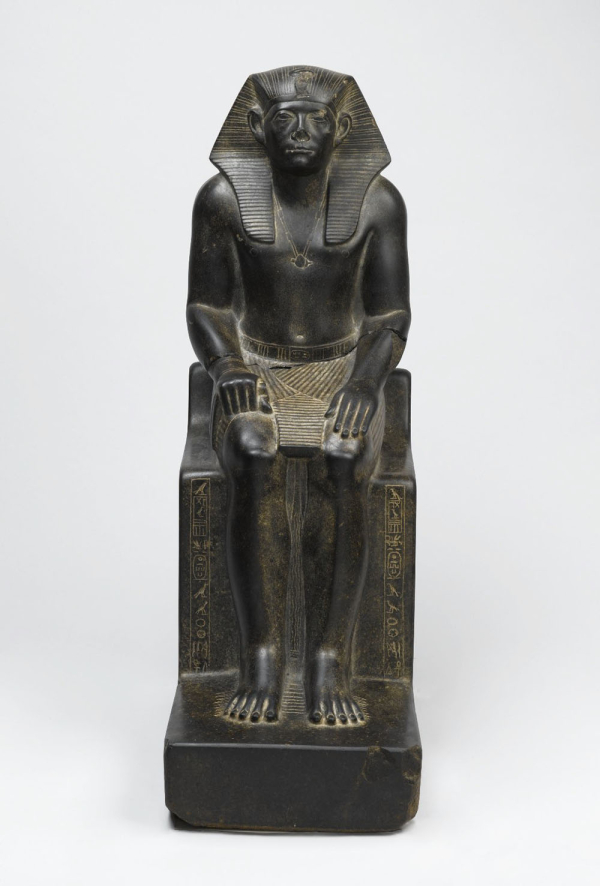
Senwosret III. Egypt, from Hierakonpolis. Middle Kingdom, Dynasty 12, reign of Senwosret III, circa 1836–1818 B.C.E. Granite, 217⁄16 x 71⁄2 x 1311⁄16 in. (54.5 × 19 × 34.7 cm). Brooklyn Museum, Charles Edwin Wilbour Fund, 52.1
A masterpiece of Middle Kingdom royal sculpture, this statue of the Twelfth Dynasty king Senwosret III encapsulates one basic theme of this installation: the interaction between permanence and change. By the time an artist carved this piece, the seated pose had been part of Egyptian tradition for more than eight hundred years; most of the elements of the costume had been around even longer. However, the style of carving—note Senwosret’s expressive face—had been in vogue for less than a generation.

Bust of the Goddess Sakhmet. Egypt, from Thebes. New Kingdom, Dynasty 18, reign of Amunhotep III, circa 1390–1352 B.C.E. Granodiorite, 39 × 197⁄8 x 159⁄16 in. (99 × 50.5 × 39.5 cm). Brooklyn Museum, Gift of Dr. and Mrs. W. Benson Harer, Jr. in honor of Richard Fazzini and the excavations of the Temple of Mut in South Karnak; the Mary Smith Dorward Fund; and the Charles Edwin Wilbour Fund, 1991.311
Sakhmet, whose name means “The Powerful One,” wears a sun-disk and cobra on her brow, identifying her as the daughter of the sun-god Re. In her role as the Eye of Re, Sakhmet was dispatched abroad to destroy Egypt’s enemies. Angered because Re set another goddess in her place while she was away, the Eye refused to return and protect Egypt, until pacified by wine, music, and dance.
The Egyptians explained the sun’s annual motion toward the south and then back to Egypt as the Eye’s departure and return. In other myths, Re’s Eye symbolized natural phenomena, such as the Nile’s annual flood and the Egyptian new year.

Head from a Female Sphinx. Found in Italy, said to have been in the ruins of Emperor Hadrian’s villa at Tivoli, outside Rome; originally from Egypt, probably Heliopolis. Middle Kingdom, Dynasty 12, reign of Amunemhat II, circa 1876–1842 B.C.E. Chlorite, 155⁄16 x 131⁄8 x 1315⁄16 in. (38.9 × 33.3 × 35.4 cm). Brooklyn Museum, Charles Edwin Wilbour Fund, 56.85
Small details sometimes provide crucial clues to understanding a sculpture. On this object, for example, the back of the wig extends horizontally instead of downward, indicating that the head originally belonged to a sphinx, a mythological creature with a human head and a lion’s body. Sphinxes represented the king’s ability to crush Egypt’s enemies. Although sphinxes were usually male, the heavy striated wig shown here only appears on representations of women.
This statue’s inlaid eyes, probably of metal and colored stones, were pried out in antiquity, resulting in extensive damage. Repairs to the eyes, lips, and chin were apparently made in the eighteenth century.
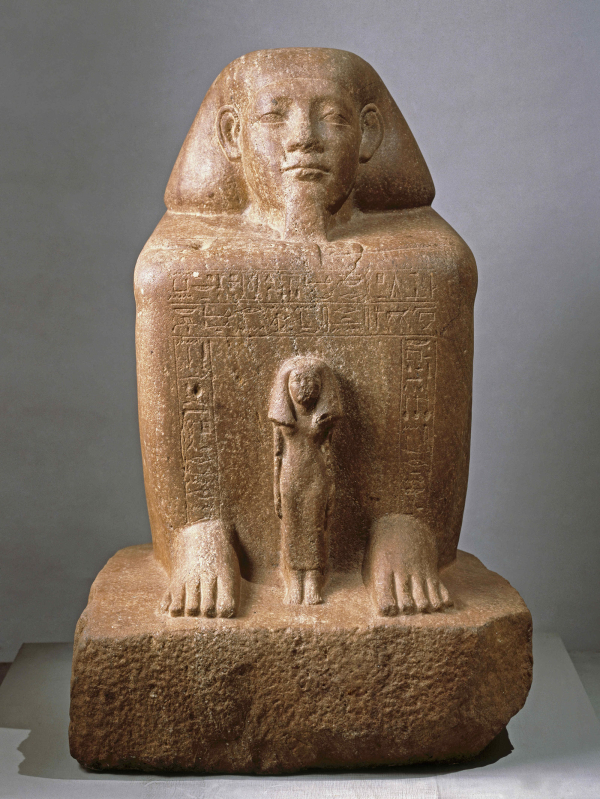
Block Statue of Senwosret-senebnefny. Egypt, exact provenance not known. Middle Kingdom, late Dynasty 12, circa 1836–1759 B.C.E. Quartzite, 267⁄8 x 165⁄16 x 181⁄8 in. (68.3 × 41.5 × 46 cm). Brooklyn Museum, Charles Edwin Wilbour Fund, 39.602
Block statues show their subjects—almost always male—seated on the ground with their knees drawn to their chests; a cloak usually envelops the limbs and torso. The resulting block-like form gives these statues their name.
Block statues first appeared in the Twelfth Dynasty, nearly one thousand years after most statue types had been developed. Some Egyptologists suggest that the invention of such a distinctive sculptural form probably reflected the emergence of new religious ideas. The Twelfth Dynasty witnessed an increase in the belief that a non-royal person’s spirit could be reborn after death. Some scholars have suggested that the block statue represents the spirit as it emerges from a mound in the underworld at the glorious moment of rebirth.
Others see it as a demonstration of the intensification of personal piety that occurred during the period. Most early block statues were found in temples. Because the squatting pose in Egyptian art conveys submission, block statues are thought to depict men observing temple priests as they perform rituals for the gods, like obedient members of an eternal audience.

Coffin and Mummy Board of Pa-seba-khai-en-ipet. Egypt, from Thebes. Third Intermediate Period, circa 1070–945 B.C.E. Wood, painted, 763⁄8 x 215⁄8 x 125⁄8 in. (194 × 55 × 32 cm). Brooklyn Museum, Charles Edwin Wilbour Fund, 08.480.2a–c
Magical decoration ensuring the deceased’s wishes was at first put on tomb walls, but in Dynasty 21, the most elaborate decoration began to appear primarily on coffins.
The lid of this coffin shows Osiris, the god of the dead, depicted multiple times; Nut, the sky goddess; and, on the interior, the goddess of the afterlife—three deities who together create a miniature universe for the mummy to inhabit. The outsides of the box depict the deceased’s journey to the afterlife, including the final judgment by weighing his heart against the feather of truth, while the mummy board shows him as a living presence arrived in the next world.
Carbon-14 dating conducted in 2009 indicates that Pasebakhaienipet, who was the mayor of Thebes, died between 1110 and 939 B.C.E., a date supported by the Twenty-first Dynasty style of his coffin. His elaborate coffin and mummification in the most expensive style suggest his high status in Egyptian society.

Book of the Dead of the Goldworker of Amun, Sobekmose. Egypt, from Saqqara. New Kingdom, Dynasty 18, probably reign of Thutmose III to reign of Amunhotep II (circa 1479–1400 B.C.E.). Papyrus, ink, pigment, 14 × 2882⁄3 in. (35.6 × 733.2 cm). Brooklyn Museum, Charles Edwin Wilbour Fund, 37.1777E
This is one of the most important religious texts of the New Kingdom, in part because it is an early version of the Book of the Dead, revealing the development of all later ones. The papyrus is about twenty-five feet long, inscribed on both sides (a rare feature), and contains nearly one hundred “chapters,” almost half of the total known group of Book of the Dead texts. Several of the chapters are closer to those found in the Coffin Texts, the collection of funeral texts used in the previous period.
The texts on the recto (or front side) are written in approximately 530 columns of hieroglyphs reading down and from right to left. English translations are provided for certain key passages. Understanding these evocative texts can be challenging; even Egyptologists cannot claim with certainty that they know what some of the phrases and sentences mean. (A full translation of this Book of the Dead has been undertaken and will be published by the Museum.)

Cartonnage and Mummy of an Anonymous Man. Egypt, excavated in Deir el Bahri. Roman Period, 3rd century C.E. Linen, plaster, paint, organic materials; cartonnage: 131⁄4 × 357⁄16 in. (33.7 × 90 cm); mummy, approximately: 8 × 20 × 62 in. (20.3 × 50.8 × 157.5 cm). Brooklyn Museum, Charles Edwin Wilbour Fund, 52.128a–e
This cartonnage illustrates the combination of Egyptian with Classical art in the Roman Period: the idealized portrait includes the hieroglyph for “protection” (a symbol of Isis) as well as a wreath (in the Greek or Roman style). The red symbol on the left shoulder, which can easily be mistaken for a swastika, is actually an ancient Greek symbol for holiness, while at the bottom, the boat of Sokar (a form of the Egyptian sun god) is flanked by jackals.
Mummy of an Anonymous Man was unwrapped in the 1950s, when it was the subject of a TV show, and rewrapped in 2010 for this exhibition. Carbon-14 dating conducted in 2009 suggests that this man died between 259 and 398 C.E., confirming the third-century date suggested by the style of the cartonnage.
![The Mummy of Demetri[o]s](jpg/2016_ancient_egyptian_art_11.600a-b_top_ps1_3500w_600_894.jpg)
The Mummy of Demetri[o]s, 95–100 C.E. Painted cloth, gold, human remains, wood, encaustic, gilding, 133⁄8 x 153⁄8 x 7413⁄16 in., 130 lb. (34 x 39 x 190 cm, 58.97kg). Brooklyn Museum, Charles Edwin Wilbour Fund, 11.600
Egypt was a truly multicultural society. Although mummifying the dead was an Egyptian tradition, the name Demetrios inscribed on the mummy's linen wrapping indicates that this man was Greek. The red pigment on his linen shroud was made with lead imported from Spain. His portrait, painted on a wooden panel in the medium of encaustic (wax with pigment), is Roman in style. The gold leaf decoration on the linen includes Egyptian divinities and Demetrios's name and his age at death, fifty-nine, written in Greek.
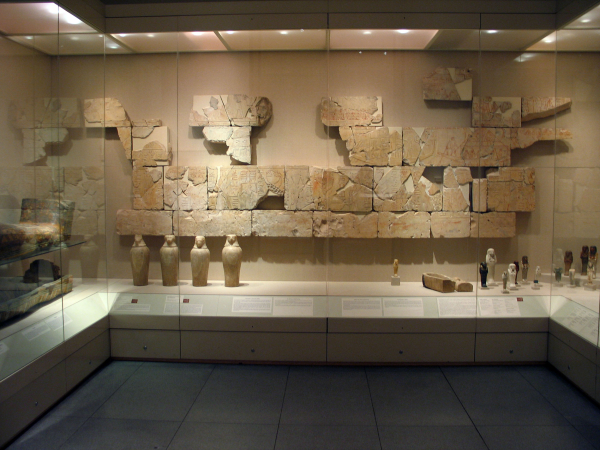
Nes-Peka-Shuti Relief, circa 664–610 B.C.E. Limestone, 93⁄4 × 291⁄2 in. (24.8 × 74.9 cm). Brooklyn Museum, Charles Edwin Wilbour Fund, 52.131.1–32
Tomb reliefs magically repeated the rituals required to transport the deceased to the afterlife and maintain him or her once there. The wealthier the individual, the more elaborate the decoration of the tomb. Nespeqashuty was a vizier, the highest ranking government official.
The decoration of Nespeqashuty’s tomb was never completed, allowing a rare glimpse into the artist’s working process. The three steps of relief carving are clearly visible here. First, each scene was drawn in color with attention paid to every detail. Next, the outline of each figure was carved and the background cut away. Finally, another carving of the figures softened the contour lines and sculpted the internal details.
The graffiti on the relief were written in both Demotic and Coptic, the two latest stages of the Egyptian language, as well as in Greek, during a thousand-year period after the tomb was prepared for Nespeqashuty. Writing graffiti in the tomb was a pious act, not vandalism.
Ancient Egyptian Art
Long-Term Installation
Egyptian Galleries, 3rd Floor
Our collection of ancient Egyptian art, one of the largest and finest in the United States, is renowned throughout the world. The galleries for this unparalleled collection have been reorganized and reinstalled.
The ancient Egyptians were an indigenous African people who first appeared in the southern (Upper Egypt) Nile Valley by 4500 B.C.E. and spread northward to Lower Egypt. Joined over five thousand years by other Africans from Nubia and Libya, as well as Semites, Persians, Greeks, and Romans, their distinctly multicultural society produced an astonishing array of objects and structures.
Egypt is the oldest continuously documented civilization on the African continent, and our collection, begun in 1902, tells the story of its art from its earliest known origins until the Roman period.
Our Egyptian galleries contain more than 1,200 objects that include sculpture, relief, paintings, pottery, and papyri. On view are such treasures as a wooden and gilded statuette of Amunhotep III, an exquisite chlorite head of a Middle Kingdom princess, an early stone deity from 2650 B.C.E., a relief from the tomb of a man named Akhty-hotep, and a highly abstract female terracotta statuette created over five thousand years ago.
The Mummy Chamber is a special section that explores the rituals related to mummification and the Egyptian belief that the body must be preserved to ensure eternal life. On view are the elaborately decorated coffin and mummy board of the mayor of Thebes, Pasebakhaienipet; wall reliefs from the tomb of the vizier Nespeqashuty; several mummies; and a nearly twenty-five-foot-long Book of the Dead scroll.
This installation is organized by Edward Bleiberg, Curator of Egyptian Art, with Yekaterina Barbash, Associate Curator of Egyptian Art.
Generous support for the installation of the Introduction and Early Egypt galleries as a part of the Brooklyn Museum’s Countdown to Launch initiatives is provided by the Elizabeth A. Sackler Museum Educational Trust, the Jerome Levy Foundation, the Frederick and Diana Elghanayan Family Foundation, and Richard A. Fazzini and Mary E. McKercher.

